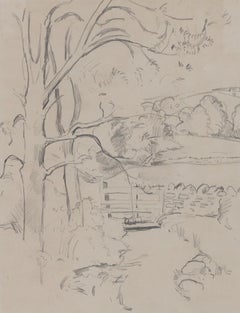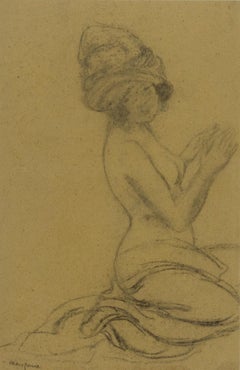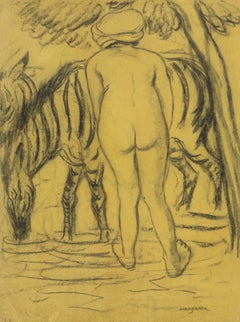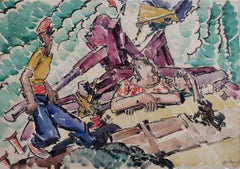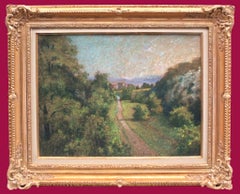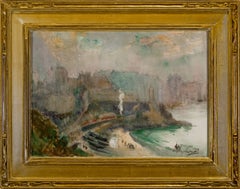1910s Art
to
90
140
80
97
60
31
Overall Width
to
Overall Height
to
14
1,180
14,507
16,229
395
422
836
558
712
1,258
942
839
709
597
11
424
291
140
131
47
18
16
6
5
1
241
154
7
183
91
50
43
40
39
34
26
25
18
18
18
15
14
14
14
12
11
10
10
302
263
164
160
43
12
11
10
7
6
271
24
282
138
Period: 1910s
Style: Impressionist
Style: Post-Impressionist
Landscape with Gate by Orovida Pissarro - Drawing
Located in London, GB
Landscape with Gate by Orovida Pissarro (1893-1968)
Pencil on paper
25.7 x 20.4 cm (10 ¹/₈ x 8 inches)
Executed circa 1917
Artist biography:
Orovida Camille Pissarro, Lucien and Esther Pissarro’s only child, was the first woman in the Pissarro family as well as the first of her generation to become an artist. Born in Epping, England in 1893, she lived and worked predominantly in London where she became a prominent member of several British arts clubs and societies.
She first learned to paint in the Impressionist style of her father, but after a brief period of formal study with Walter Sickert in 1913 she renounced formal art schooling. Throughout her career, Orovida always remained outside of any mainstream British art movements. Much to Lucien's disappointment she soon turned away from naturalistic painting and developed her own unusual style combining elements of Japanese, Chinese, Persian and Indian art. Her rejection of Impressionism, which for the Pissarro family had become a way of life, together with the simultaneous decision to drop her famous last name and simply use Orovida as a ‘nom de peintre’, reflected a deep desire for independence and distance from the weight of the family legacy.
Orovida's most distinctive and notable works were produced from the period of 1919 to 1939 using her own homemade egg tempera applied in thin, delicate washes to silk, linen or paper and sometimes embellished with brocade borders. These elegant and richly decorative works generally depict Eastern, Asian and African subjects, such as Mongolian horse...
Category
Post-Impressionist 1910s Art
Materials
Paper, Pencil
Une Femme Turque by Georges Manzana Pissarro - Work on paper
Located in London, GB
Une Femme Turque by Georges Manzana Pissarro (1871-1961)
Charcoal on paper
47 x 30.5 cm (18 ¹/₂ x 12 inches)
Signed lower left, manzana
Executed circa 1910
This work is accompanied ...
Category
Post-Impressionist 1910s Art
Materials
Charcoal
Jeune Femme de Dos au Zèbre by Georges Manzana Pissarro - Nude drawing
Located in London, GB
Jeune Femme de Dos au Zèbre by Georges Manzana Pissarro (1871-1961)
Charcoal on paper
66 x 49 cm (26 x 19 ¼ inches)
Signed lower right, Manzana
Executed circa 1915
This work is acco...
Category
Post-Impressionist 1910s Art
Materials
Paper, Charcoal
Fisherman and Family on Boat
Located in Miami, FL
Walt Lauderback like Dean Cornwell represents the pinnacle of the Golden Age of American Illustration. Based on the signature, this watercolor of a family with dog on boat appears ...
Category
Post-Impressionist 1910s Art
Materials
Watercolor
The Path Towards the Village
Located in Saint-Ouen, FR
PRINS Pierre Ernest (1838-1913)
Pastel on card signed low right and dated 1912
Luxury frame gilded with gold leaves with protective glass cover
Card Size ...
Category
Post-Impressionist 1910s Art
Materials
Oil
"St. Ives in the Evening"
By Hayley Lever
Located in Lambertville, NJ
Jim’s of Lambertville is proud to offer this artwork.
Signed and dated lower right.
Hayley Lever (1876-1958)
Hayley Lever's exceptional career path took him from the shores of ...
Category
American Impressionist 1910s Art
Materials
Watercolor
A Study of Human Head and Tiger by Orovida Pissarro - Sketch
Located in London, GB
A Study of Human Head and Tiger by Orovida Pissarro (1893-1968)
Pencil on paper
25.5 x 20 cm (10 x 7⁷/₈ inches)
Executed circa 1917
Artist biography:
Orovida Camille Pissarro, Lucie...
Category
Post-Impressionist 1910s Art
Materials
Paper, Pencil
Interiør Fra Liselund (Interior from Liselund)
Located in New York, NY
Peter Ilsted's "Dining Room at Liselund Manor" from 1917 is not only a remarkable illustration of the Copenhagen Interior School's aesthetic but also a profound exploration of the co...
Category
Post-Impressionist 1910s Art
Materials
Canvas, Oil
" The Littlefield Murals " 3 MURALS OF THE XIT RANCH IN TEXAS. PAINTED Ca. 1910
Located in San Antonio, TX
Major George Washington Littlefield died in 1920. He commissioned E. Martin Hennings around 1910 to do six large paintings of scenes from his 235,000-acre ( part of the XIT ) ranch to hang in his bank in Austin.
I am not sure, but the bank possibly went under sometime in the 197s-1980s. All of the art and antiques were stored, and they had a sale. We have 3 of the six murals that were commissioned by Littlefield.
I have about 40 pages of info on Littlefield and the murals. Too much to enter now but I will be scanning that info later this week.
The Littlefield mansion is still in Downtown Austin. At one time he was the richest man in the state. He was UT's biggest donor for several years prior to his death.
The paintings are
34 x 130
35 x 144
35 x 119
Two are hanging in my friend's ranch house. The other is of a large herd of Hereford Cattle. It is actually pictured
on the cover of the Biography of George Washing Littlefield.
Littlefield, George Washington (1842–1920). George Washington Littlefield, cattleman, banker, and member of the Board of Regents of the University of Texas, son of Fleming and Mildred Terrell (Satterwhite) White Littlefield, was born in Panola County, Mississippi, on June 21, 1842. The family moved to Texas in 1850 after a confrontation between Fleming Littlefield and his wife's family. In marrying Fleming, her overseer, after the death of her first husband, Mildred in her family's eyes had married beneath her station, an action to which her family objected. George grew to young manhood on the family plantation near Belmont, Gonzales County, helping his mother to manage the place after Fleming's death in 1853. George received a basic education in Gonzales College and Baylor University, 1853–55 and 1857. With the outbreak of the Civil War in 1861 George enlisted in Company I, Eighth Texas Cavalry (Terry's Texas Rangers), which fought in the Army of Tennessee. Before his military career was ended at Mossy Creek, Tennessee, on December 26, 1863, by an exploding cannon shell, George rose to the rank of company commander, the youngest in his regiment, and fought at Shiloh, Perryville, and Chickamauga. At Mossy Creek he was promoted to major, a title by which he was addressed after the mid 1880s. Back in Texas after being discharged in 1864, he took control of a plantation belonging to himself and his brother, and "went to work to make the best, as he thought, of a miserable life, having to carry his crutches everywhere." During the war, on January 14, 1863, George married Alice Payne Tillar, with whom he had two children, both of whom died in infancy. In his business ventures thereafter, George Littlefield, who had a highly developed sense of family, utilized nephews and the husbands of nieces as managers.
George's first year's farming after the war ended in disaster caused by three years of worm infestation and flood. Even the road-side store he opened, which prospered because George accepted barter, in particular cattle, could not make up for the losses. In 1871 he gathered a herd of cattle, half of which were his and the rest belonging to his brother, bought more, and drove the herd to Abilene, Kansas, where he sold the animals for enough to discharge all of his debts and leave him with $3,600 "to begin business." Over the next several years entrepreneur Littlefield opened a dry goods store in partnership with J. C. Dilworth in Gonzales, bought and trailed cattle, bought ranches in Caldwell and Hays counties, and developed his plantations. In the trailing business, Littlefield commonly bought his cattle, rather than, as most trailing contractors did, trailing them for a fee. He took the greater risk but reaped the greater reward in their sale. In 1877 Littlefield bought water rights along the Canadian River near Tascosa and established the XIT Ranch which he sold in 1881 for $248,000. Littlefield rejoiced that he had obtained "far more money than he had ever expected to have" and thought of retiring at thirty-nine years of age. But he did not retire, as "he learned. . .that the more money a man makes, the more he has to make, that a man's world opens up a little bit wider with each deal and demands become heavier."
In 1882 Littlefield followed the advice of his principal ranch manager, half-nephew J. Phelps White, and purchased water interests sufficient to control some four million acres of land in New Mexico east of the Pecos River between Fort Sumner and Roswell, on which he established the Bosque Grande Ranch. In 1883 he bought the site of the first windmill on the New Mexico plains at the Four Lakes north of Tatum and developed the Four Lakes Ranch with windmills and barbed wire to control access to water and permit upgrading of stock. His cattle after 1882 carried his LFD brand on their right side. In 1887 Littlefield began acquiring land in Mason County, which soon spread over some 120,000 acres in adjacent Kimble and Menard counties, a ranch he put under management of half-nephew John Will White. In the 1890s Littlefield assembled acreage that came to be known as the LFD Farm in Roswell, New Mexico, on which he established an apple grove, grew forage for cattle, recruited his horses prior to the spring round-up, and maintained the pure-bred bulls that he used to upgrade his herds. Littlefield climaxed his ranching operation in 1901 with the purchase for two dollars per acre of 235,858 acres of the Yellow House (southern) Division of the XIT Ranch in Lamb and Hockley counties. To reach the prevailing wind above the escarpment at the ranch headquarters, Littlefield put up a windmill 130 feet tall to the top of the fan, claimed at the time to be the world's tallest windmill. In 1912 he established the Littlefield Lands Company under Arthur Pope...
Category
Impressionist 1910s Art
Materials
Oil
Monumental Painting -- After The Storm
Located in Milford, NH
An exceptional impressionist beachside scene with figures and powerful clouds by American artist Augustus B. Koopman (1869-1914). Koopman was born in Charlotte, North Carolina, initially studied at the Pennsylvania Academy of Fine arts, and going on to live a large portion of his short life in Paris, studying at the Academie Julian and the Ecole des Beaux Arts, painting many of his marine and figure paintings on the coast at Etaples, near Belgium. Among his teachers were William Bouguereau, Benjamin Constant, and Tony Robert-Fleury. He was well known for his genre, maritime, landscape, figure, and portrait paintings. His drypoints and etchings can be found in both the Congressional and New York Public Libraries, and his painting “Vision of the Grand Canyon” is displayed in the Santa Fe Railway...
Category
American Impressionist 1910s Art
Materials
Canvas, Oil
"Mlle Landsberg" (grade planche, pl. 16)
Located in Missouri, MO
"Mlle Landsberg" (grade planche, pl. 16), 1914
Henri Matisse (French, 1869-1954)
Signed and Numbered Lower Right
Edition 12/15
Image size: 7 7/8 x 4 5/16 inches
Sheet size: 17 11/16 x 12 1/2 inches
With frame: 19 1/2 x 14 1/2 inches
Henri Matisse came from a family who were of Flemish origin and lived near the Belgian border. At eight o'clock on the evening of December 31, 1869, he was born in his grandparents' home in the town of Le Cateau in the cheerless far north of France. His father was a self-made seed merchant who was a mixture of determination and tightly coiled tension.
Henri had no clear idea of what he wanted to do with his life. He was a twenty-year-old law clerk convalescing from appendicitis when he first began to paint, using a box of colors given to him by his mother. Little more than a year later, in 1890, he had abandoned law and was studying art in Paris. The classes consisted of drawing from plaster casts and nude models and of copying paintings in the Louvre. He soon rebelled against the school's conservative atmosphere; he replaced the dark tones of his earliest works with brighter colors that reflected his awareness of Impressionism. Matisse was also a violinist; he took an odd pride in the notion that if his painting eye failed, he could support his family by fiddling on the streets of Paris.
Henri found a girlfriend while studying art, and he fathered a daughter, Marguerite, by her in 1894. In 1898 he married another woman, Amelie Parayre. She adopted the beloved Marguerite; they eventually had two sons, Jean, a sculptor and Pierre who became an eminent art dealer. Relations between Matisse and his wife were often strained. He often dallied with other women, and they finally separated in 1939 over a model who had been hired as a companion for Mme. Matisse. She was Madame Lydia, and after Mme. Matisse left, she remained with Matisse until he died.
Matisse spent the summer of 1905 working with Andre Derain in the small Mediterranean seaport of Collioure. They began using bright and dissonant colors. When they and their colleagues exhibited together, they caused a sensation. The critics and the public considered their paintings to be so crude and so roughly crafted that the group became known as Les Fauves (the wild beasts).
By 1907, Matisse moved on from the concerns of Fauvism and turned his attention to studies of the human figure. He had begun to sculpt a few years earlier. In 1910, when he saw an exhibition of Islamic art, he was fascinated with the multiple patterned areas and adapted the decorative universe of the miniatures to his interiors. As a continuation of his interest in the "exotic", Matisse made extended trips to Morocco in 1912 and 1913.
At the end of 1917, Matisse moved to Nice; he would spend part of each year there for the remainder of his life. A meticulous dandy, he wore a light tweed jacket amd a tie when he painted. He never used a palette, but instead squeezed his colors on to plain white kitchen dishes...
Category
Fauvist 1910s Art
Materials
Drypoint, Etching
Summer Idle
Located in Missouri, MO
Edward Cucuel (American, 1875-1954)
Summer Idle, 1918
Signed Lower Right
35 x 43 inches
43 x 51 inches with frame
Born in San Francisco, Edward Cucuel was an Impressionist painter o...
Category
American Impressionist 1910s Art
Materials
Canvas, Oil
The Opium Smoker; The Opium Eater
Located in Greenville, DE
The Opium Smoker; The Opium Eater by N.C. Wyeth was created in 1913. The painting is signed upper right. Dedication lower left that reads "To Swayne / Fro...
Category
Impressionist 1910s Art
Materials
Canvas, Oil
Lesser Ury - Auf dem kanal, impressionist, pastel, german, waterscape, canal
By Lesser Ury
Located in London, GB
Lesser Ury (1861-1931)
Auf dem Kanal
1912
pastel on board
49.2 x 34.9 cm
signed and dated 'L.Ury.1912.' (lower left)
Price:
$25,000 USD
Provenance:
Sale: Christie's London, 30 June 2000, lot 42
Collection of Simone and Jean Tiroche (acquired at the above sale)
Thence by descent
Sale: Christie's London, 19 June 2013, lot 199
Private collection, UK (acquired from the above sale)
Notes:
Dr Sibylle Gross has confirmed the authenticity of this work.
Lesser Ury, a German-Jewish Impressionist...
Category
Impressionist 1910s Art
Materials
Pastel, Board
Central Park Autumn
Located in Missouri, MO
Paul Cornoyer
“Central Park Autumn” c. 1910
Oil on Canvas
Framed Size: approx 29 x 35 inches
Canvas Size: approx 22 x 26.5 inches
Provenance: The Artist to Private Collection, St. Louis thence by Descent
Conservation report: Excellent condition. On original canvas, not relined. No in-painting.
Paul Cornoyer was born in 1864 in St. Louis, Missouri. He studied there at the School of Fine Arts in 1881. His first works were in a Barbizon mode, and his first exhibit was in 1887. In 1889, he went to Paris for further training, studying at the Academie Julien, and returned to St. Louis in 1894.
By the early 1890s, his work was more lyrical and Tonal, and he applied this style to subjects such as cityscapes and landscapes. In 1894, he painted a mural depicting the birth of St. Louis for the Planters Hotel in that city. His activities during the next six years were not particularly profitable, however, and the whereabouts of his St. Louis paintings are scarcely known. One exception is the triptych, A View of Saint Louis, with its strong urban realism. It shows the Eads Bridge...
Category
American Impressionist 1910s Art
Materials
Canvas, Oil
Les Otages Civils
Located in San Francisco, CA
This artwork titled, Les Otages Civils, 1916 is an original lithograph on Japan paper by Swiss/French artist Theophile Alexandre Steinlen, 1859-1923. It is signed and numbered out of...
Category
Impressionist 1910s Art
Materials
Lithograph
Recently Viewed
View AllMore Ways To Browse
Vintage Filling Stations
Dior Speedy Vintage
Evariste Carpentier
Gordon Gilkey
Venice Moretti
Vincent Leroy
Vintage Bakers Hutch
Vintage Cancan Dancer
Vintage Dutch Barge
Vintage Pink Floyd
Alexandre Cabanel Venus
Black Forest Bear Brush
Vertes Dancing
Victorias Secret Dress
Vintage Dental Posters
Califano Painting
Coppia Ritratto
De Clerck
